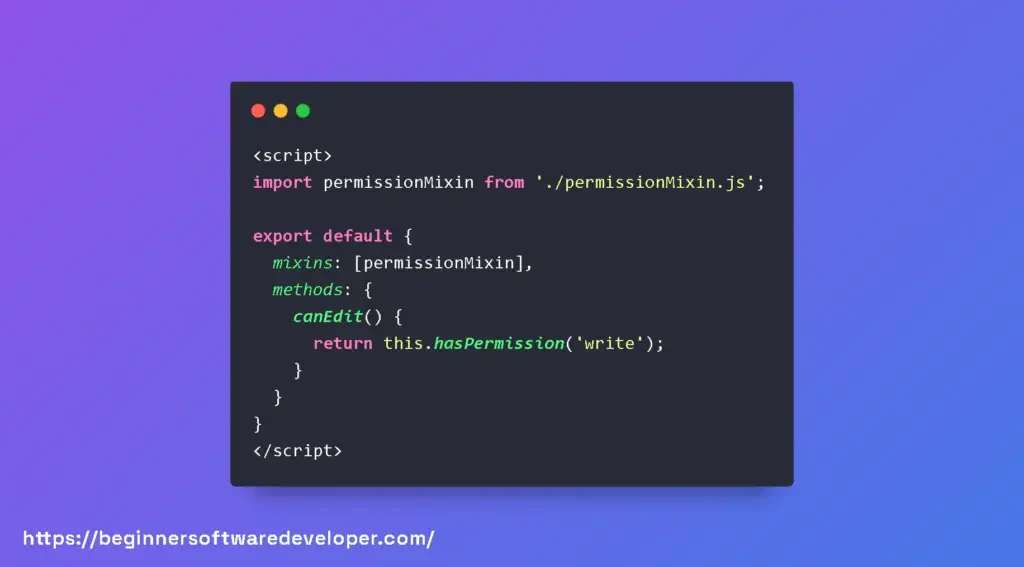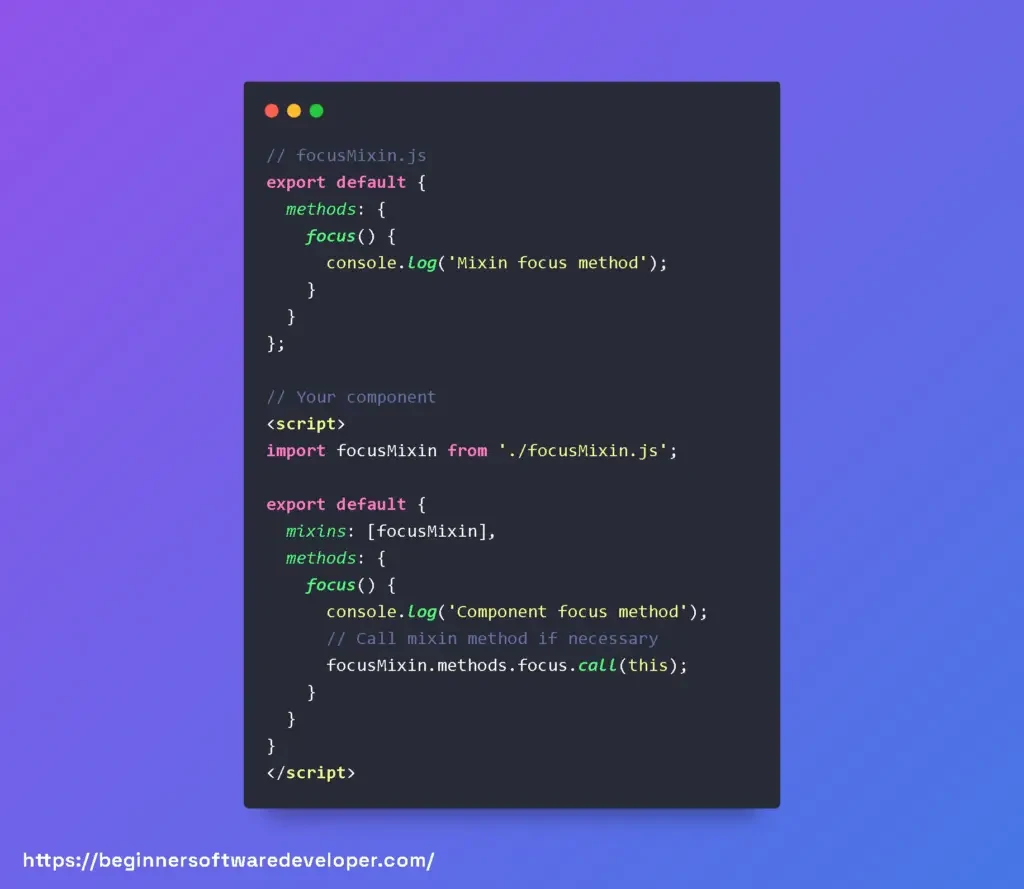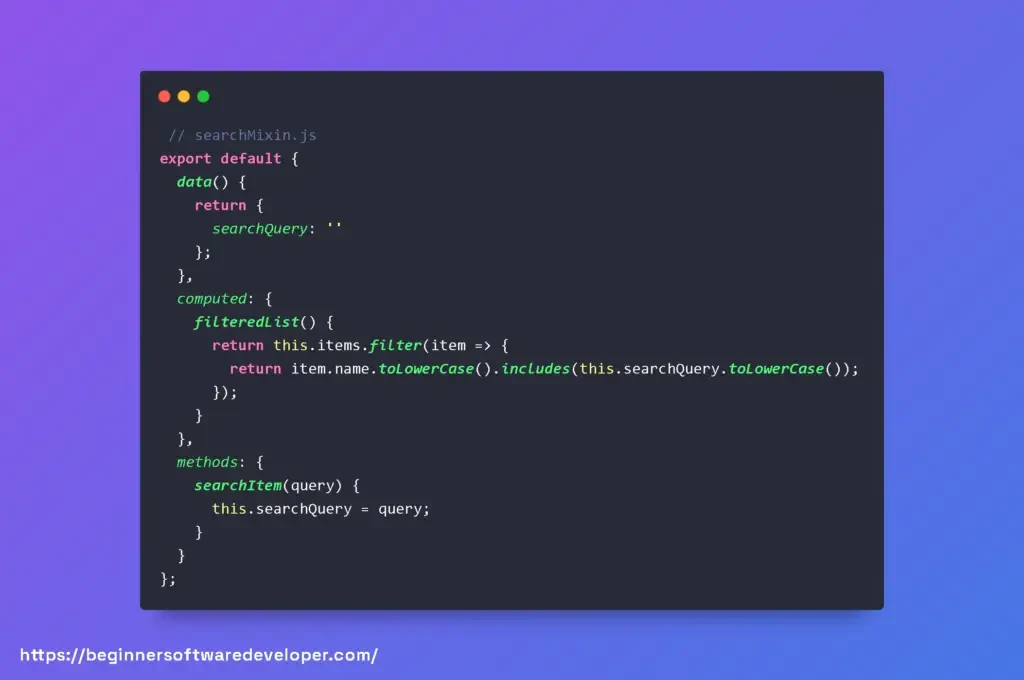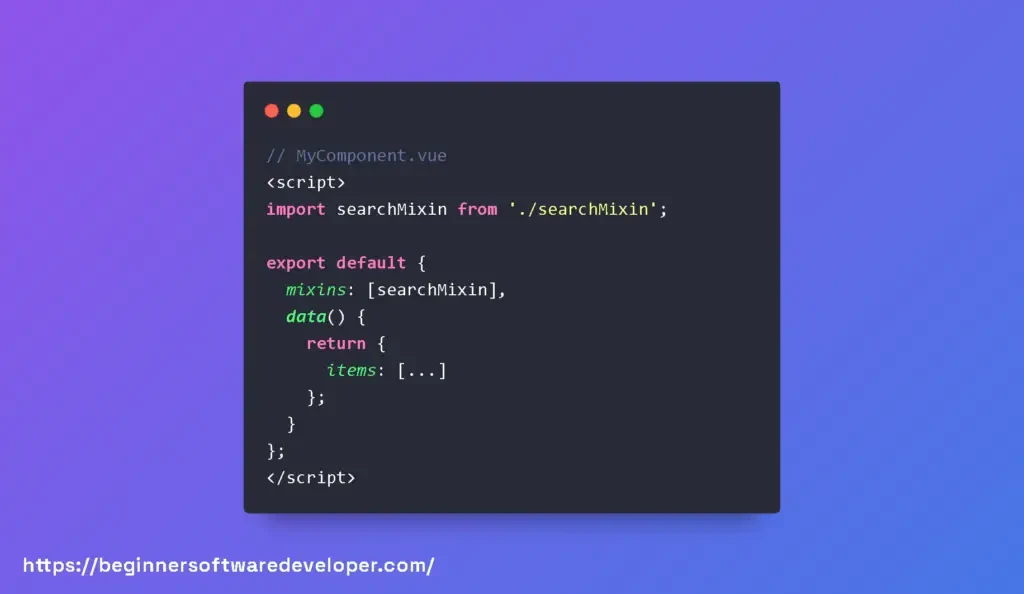Vue Mixin are a powerful tool in Vue.js that enables you to extract common functionality into reusable code snippets and apply them to multiple components.
In this article, I will share my insights from working as a Vue.js software developer for over 5 years. We will dive into the world of Vue mixins, providing you with step-by-step instructions on how to use Vue mixin effectively.
Along the way, we will showcase numerous real-world examples to illustrate how mixins can enhance your Vue.js development workflow, enabling you to create cleaner, more modular code.
No products found.
If you want to learn more about Learn To Use Vue CSS Variables With Vue Examples
Vue Mixin
Vue mixin is essentially an object containing reusable code, such as methods, data properties, computed properties, and lifecycle hooks, that can be merged with the options of any Vue component.
What Is Vue Mixin?
What Is Vue Mixin? Vue Mixins are a powerful feature in the Vue.js framework that allow developers to reuse and share functionality across multiple components.
A mixin is essentially an object containing reusable code, such as methods, data properties, computed properties, and lifecycle hooks, that can be merged with the options of any Vue component.
When a mixin is applied to a component, all the properties and methods defined in the mixin are added to the component’s own options, effectively extending its functionality.
This enables developers to modularize and organize their code by separating common logic into mixins, making it easier to maintain and reuse code across different components.
Mixins serve as a way to implement cross-cutting concerns in Vue applications.
They can be used to encapsulate and share code related to features like user authentication, form validation, event handling, and more.
By using mixins, developers can avoid duplicating code and improve code reusability, leading to more efficient and scalable Vue applications.
How Do Mixins Work In Vue?
Mixins in Vue work by merging the options of a mixin object with the options of a Vue component.
When a component uses a mixin, the properties and methods defined in the mixin become part of the component’s own options.
To apply a mixin to a Vue component, you can use the mixins property in the component’s options.
The mixins property should be an array that contains one or more mixin objects. For example:
In the above example, the myMixin object defines a greet method.
By including myMixin in the mixins array of the myComponent component, the greet method becomes accessible within the component.
When merging options, Vue follows a specific order of precedence: the component’s own options take precedence over the options from mixins, and if there are conflicts, the component’s options override those of the mixins.
Mixins are also reactive, meaning that any data properties or computed properties defined in the mixin will work seamlessly with the component’s reactivity system.
This allows mixins to enhance components with additional state and computed values, providing a convenient way to share data and computed values among multiple components.
Check out my article about Learn Migrating Vue 2 To Vue 3 With Vue Migration Examples.
Mastering Vue Mixins: In-Depth Examples for Enhanced Components
Enhancing Vue Components with Mixins: Your Guide to Reusable Code
Mixins in Vue are a powerful feature that allows you to create reusable chunks of code that can be injected into your components, thus enhancing functionality and keeping your codebase DRY (Don’t Repeat Yourself).
Let’s dive into some practical code examples and explore best practices for implementing mixins effectively.
Creating and Using a Basic Vue Mixin
First off, let’s define a simple mixin. Imagine you have a set of components that need to handle user permissions. You can create a common mixin to share this logic:

Now, you can utilize this mixin in your Vue components:

Collaborating Mixins and Components’ own Options
When a mixin and the component itself contain overlapping options, Vue handles it gracefully.

The `focus` method defined in the component will override the one from the mixin. However, if needed, you can still access the mixin’s method directly.
Best Practices for Using Vue Mixins
Here are some tips to get the most out of mixins:
- Well-documented: Always document your mixins thoroughly. It’s essential for maintaining code clarity, especially for team projects.
- Scoped Functionality: Keep mixins focused. They should do one thing well.
- Use Namespaces: To avoid naming collisions and improve readability, namespace your methods, data, and computed properties in mixins.
- Global vs Local: Consider carefully whether to create global mixins (with `Vue.mixin()`) as they affect every single Vue instance created.
Now that you’re armed with these examples and tips, start experimenting with mixins in your own Vue.js projects. They can significantly reduce code redundancy and enhance component functionality in a maintainable way.
Vue Mixin Created
Vue Mixin Created: When creating a Vue mixin, you define an object that contains various properties and methods that you want to share among multiple components.
The created hook is a common option that can be included in a mixin. The created hook is called when the component using the mixin is created.
Here’s an example:
In this example, the myMixin object includes a created hook and a greet method.
When a component uses this mixin, the created hook will be called during its creation, and the greet method will be available to the component.
The created hook is useful for performing initialization tasks or fetching data when the component is created.
By including the created hook in a mixin, you can share this behavior across multiple components without duplicating the code.
Vue Mixin Data
Vue Mixin Data: In a Vue mixin, you can define data properties that will be merged with the component’s own data properties.
This allows you to share common data between multiple components without repeating the same code.
Here’s an example:
In this example, the myMixin object includes a data function that returns an object with a message property.
When a component applies this mixin, the message property will be added to the component’s own data.
In this example, the myComponent component uses the myMixin mixin. The created hook in the component can access and use the message property defined in the mixin.
By including data properties in mixins, you can share common state or configuration across multiple components, making your code more reusable and maintainable.
Vue Mixin Computed
Vue Mixin Computed: Mixins in Vue can also provide computed properties that will be merged with the component’s own computed properties.
Computed properties are functions that calculate values based on other data properties and are cached until their dependencies change.
Here’s an example:
In this example, the myMixin object includes a computed object with a reversedMessage computed property.
When a component applies this mixin, the reversedMessage property will be available in the component.
In this example, the myComponent component uses the myMixin mixin. The created hook in the component can access and use the reversedMessage computed property defined in the mixin.
By including computed properties in mixins, you can share complex calculations or derived values across multiple components, promoting code reuse and reducing duplication.
Vue Mixin Naming Convention
Vue Mixin Naming Convention: When naming Vue mixins, it is recommended to follow a consistent and descriptive naming convention.
This helps to clearly indicate the purpose and functionality of the mixin.
For example, you can use camel case or kebab case for naming mixins. Here are some examples:
In the above examples, the mixins are named according to their specific functionality.
This makes it easier to understand and identify the purpose of each mixin when they are used in components.
Using a naming convention also improves code readability and maintainability, especially when working with larger Vue applications that may have many mixins.
Don´t forget to check out my article about Learn Vue Router Hash With Vue Router Examples
Vue Mixin Typescript
Vue Mixin Typescript: When using Vue mixins with TypeScript, it’s important to define the types correctly to ensure proper type inference and validation.
This helps to catch potential errors during development and provides better autocompletion and code navigation in an IDE.
To use mixins with TypeScript, you can leverage decorators provided by libraries like vue-property-decorator or @mixin from the Vue Class Component syntax.
Here’s an example using vue-property-decorator:
In this example, the @Component decorator is used to annotate the component class, and Mixin<MyMixin>(myMixin) is used to apply the mixin to the component.
The MyMixin interface defines the expected properties and methods provided by the mixin.
By specifying the types correctly, TypeScript can perform type checking and provide helpful suggestions and error detection when working with mixins.
Vue Mixin Template
Vue Mixin Template: Mixins in Vue can also include template code that will be merged with the component’s own template. This allows you to share common UI structure or markup between multiple components.
Here’s an example:
In this example, the myMixin includes its own template code, defined as a string.
When a component applies this mixin, the mixin’s template code gets merged with the component’s template, resulting in a combined UI.
The resulting template will include both the component’s original template code and the template code defined in the mixin.
Any event handlers or methods defined in the mixin’s template will work seamlessly with the component.
By including template code in mixins, you can promote code reuse and consistency in the UI structure across multiple components.
It’s important to note that if a mixin and a component both define the same element in the template, the component’s definition takes precedence.
Don´t forget to check out my article about Vue 3 Tutorial For Beginners With Vue Tutorials.
Best Practices for Leveraging Vue Mixins to Enhance Your Components
Let´s look closer on Vue mixins and explore the best ways to utilize this powerful feature. A mixin in Vue is a great way to extract component logic and reuse it across multiple components. Think of mixins as the perfect spice blend that can flavor multiple dishes in your Vue.js project.
Best Practices for Using Vue Mixins
Here are some tips to keep your mixins easy to understand and maintain:
- Keep mixins focused: Each mixin should be responsible for a single feature or functionality. This makes it easier to manage and debug.
- Name mixins clearly: Choose names that reflect the mixin’s purpose, aiding in better comprehension and reducing the chance of conflicts.
- Document your mixins: Providing comments and documentation for the mixin’s properties and methods will save you and your team a lot of time in the future.
- Use lifecycle hooks wisely: Be cautious when including lifecycle hooks in mixins as they can be unintentionally overwritten by the component that uses the mixin.
Practical Code Example
Let’s create a mixin that adds search functionality to a component:

Now, let’s use it in our Vue component:

By following these best practices, you can create powerful, reusable components that will help keep your code DRY and your Vue.js applications scalable.
Vue 3 Mixin
Vue 3 Mixin Example
Vue 3 Mixin Example: To understand how mixins work in Vue 3, let’s consider an example.
Imagine you have two components, ComponentA and ComponentB, and both of them require some similar functionality, such as fetching data from an API.
Instead of duplicating the code in both components, you can create a mixin that contains the shared logic.
Here’s an example of how you can define a mixin in Vue 3:
In the example above, the fetchDataMixin is defined as an object that contains a data function, which initializes the necessary data properties.
It also includes a fetchData method, which simulates an API call and updates the component’s state accordingly.
Both ComponentA and ComponentB use the fetchDataMixin by including it in their mixins property.
This allows them to access the fetchData method and use it to fetch data from the API during the mounted lifecycle hook.
Vue 3 Mixin Composition API
Vue 3 Mixin Composition API: In Vue 3, the Composition API is introduced as a new way to organize and reuse component logic.
It provides a more flexible and explicit approach compared to mixins. Instead of using mixins, you can now leverage the Composition API to achieve similar functionality.
The Composition API encourages the use of functions and provides hooks like setup() to initialize and define component logic.
You can create reusable functions or modules and import them in multiple components. This promotes better code organization and improves reusability.
For example, let’s rewrite the previous mixin example using the Composition API:
In this example, we create a separate function useLogger that encapsulates the logging functionality.
The onMounted hook is used to log “Component created!” when the component is mounted.
The log function is also defined within the useLogger function and returned for use in the component.
The setup function in the component then calls the useLogger function and extracts the log function for logging custom messages.
Vue 3 Mixin Typescript
Vue 3 Mixin Typescript: When using mixins in Vue 3 with TypeScript, you can provide type annotations to ensure type safety and enable better code completion in IDEs.
TypeScript helps catch potential errors and provides better tooling support when working with mixins.
Here’s an example of using mixins with TypeScript in Vue 3:
In this TypeScript example, we define an interface MyComponent that extends the LoggerMixin.
By doing so, we ensure that the component using the mixin has access to the properties and methods defined in the mixin.
We then use the defineComponent function from Vue to define the component, providing the mixin using the mixins option.
Vue 3 Mixin Props
Vue 3 Mixin Props: In Vue 3, props can be used to pass data from parent components to child components.
Mixins can also define props that can be used across multiple components. By adding props to mixins, you can reuse and share common props definitions.
Here’s an example of defining and using props in a mixin:
In this example, the MyMixin defines a prop called message, which is of type String and is required. The component using the mixin can access and use this prop.
In the created hook of the mixin, we log the value of message. The component template then renders the message prop in a div element.
Vue 3 Mixin Migration
Vue 3 Mixin Migration: If you are migrating an existing Vue 2 codebase to Vue 3, it’s important to note that Vue 3 introduces some breaking changes related to mixins.
Vue 3 removes the Vue.mixin() global API, and instead encourages the use of the Composition API for code reuse.
To migrate from Vue 2 mixins to Vue 3, you can follow these steps:
- Identify the functionality provided by the mixin.
- Refactor the mixin code using the Composition API, extracting reusable logic into functions or modules.
- Update the components to use the refactored code or extract reusable logic as separate Composition API functions.
- Remove the mixin usage from the components and replace it with the refactored code or Composition API functions.
- By migrating to the Composition API, you can take advantage of Vue 3’s improved reactivity system, better TypeScript support, and enhanced code organization.
Remember to thoroughly test the migrated code to ensure everything works as expected and address any potential issues or compatibility concerns during the migration process.
What Is The Alternative To Mixins In Vue?
While mixins have been a popular way to share and reuse code in Vue, Vue 3 introduces the Composition API as a more flexible and powerful alternative.
The Composition API provides a cleaner and more explicit way to organize component logic and encourages the use of functions and modules.
By using the Composition API, you can create reusable functions or modules that can be imported and used in multiple components.
This approach promotes better code organization, enhances reusability, and makes it easier to manage complex component logic.
Another alternative to mixins is to leverage TypeScript’s inheritance capabilities.
By defining base classes with shared functionality and extending them in component classes, you can achieve code reuse in a more structured and type-safe manner.
Related Articles
- Differences Between Vue 2 vs Vue 3 With Vue Examples
- What Is Vuesax With Vuesax Examples
- How To Use Vue3 Image Src? Vue 3 Image Path Examples
- Learn To Use Vue Test Utils With Vue Test Examples
- Learn To Use Vue Watch With Vue.js Examples
Hopefully, you now have a better understanding of how you can use Vue Mixin.
Understanding how you can use Vue Mixin is gonna help you with containing reusable code, such as methods, data properties, computed properties, and lifecycle hooks.
